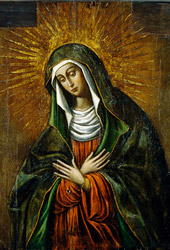Painting of the Mother of Mercy
Recent investigations show that the image of the Mother of Mercy was painted around 1620-1630 based on a work by the Flemish painter Martin de Vos (1563-1603) from the second half of the 16th century, which in turn probably was inspired by a 1580 engraving by Thomas de Leu (1560-1612). It is painted on an oak panel composed of eight boards glued together. The paint is applied over a thin base of chalk priming, a technique then typical in Northern Europe. Characteristics of the image suggest it was painted in Vilnius.
The Dawn Gate painting is rich in meaning. In it one can perceive both the Virgin, attending to the angel’s message, and the Mother of Mercy, lovingly clasping sinful humanity to her heart. The sun, starts and half-moon in the image’s cover are attributes of the Immaculate Conception, expressing the superabundance of God’s graces. The painting, enriched by the symbolism of its cover, recalls the Marian iconographic type known as Tota Pulchra. The Blessed Virgin Mary is presented as the dawn of the new creation, the Christian’s highest ideal, and one who has been justified by God’s grace alone.
Our Lady’s image was at first displayed without the metal covering. Adorning holy paintings with clothing and crowns made from precious metals is an old Lithuanian and Polish tradition, which may be inspired by Orthodox practices. It is thought that the painting of Our Lady of the Dawn Gate has been embellished with silver gilt casing since about the year 1670. Floral patterns emboss the metal cover.
Mary bears two crowns. The lower crown, worked in gilded copper, dates to about 1700. The upper crown, of gilded silver embellished with coloured glass inlays, was fashioned around 1750. On July 5, 1927 the image was adorned with new crowns blessed by Pope Pius XI. These were exact copies of the old crowns, made from gold that people donated for that purpose. During the coronation ceremony, the title Mother of Mercy was bestowed on Our Lady of the Gate of Dawn. At present, the fate of the crowns blessed by Pope Pius XI is unknown. Hidden for safekeeping at the start of World War II, their whereabouts were later forgotten.








